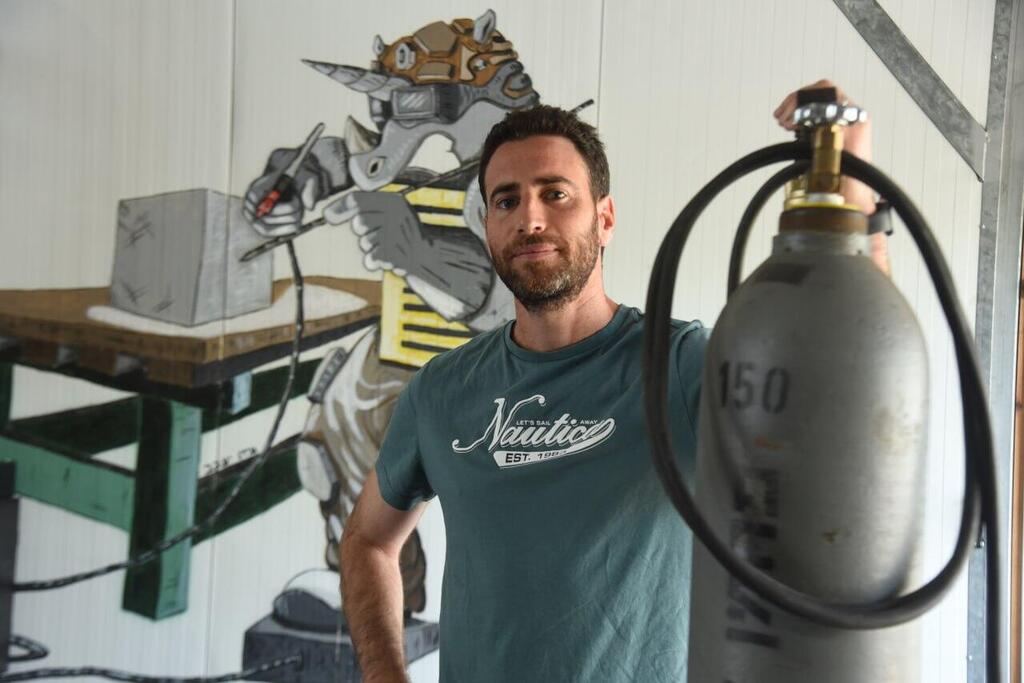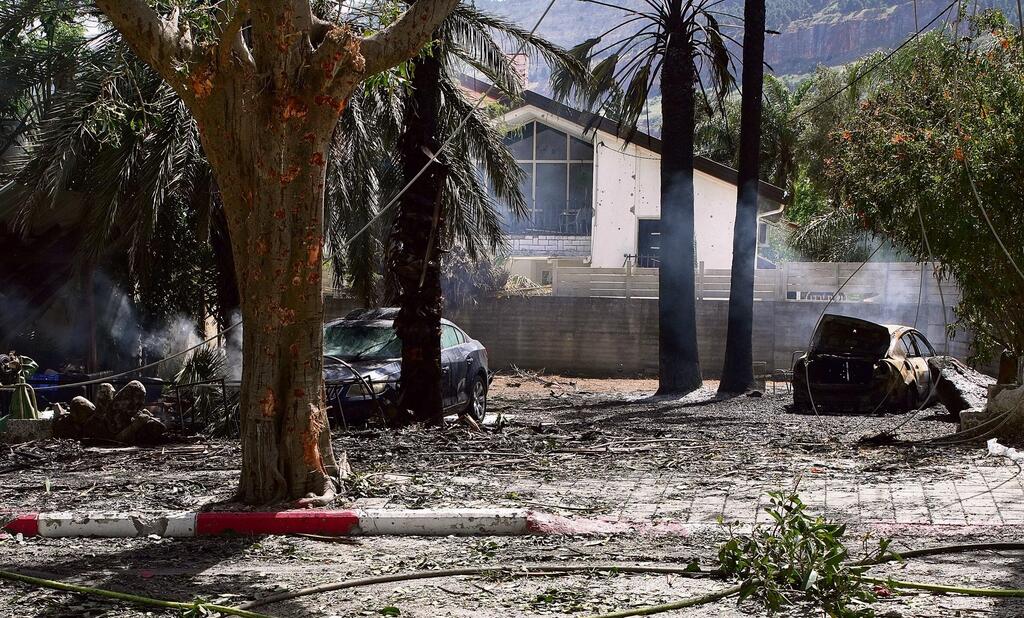Getting your Trinity Audio player ready...
Ayala Amar never imagined it would come to this. When she fled Kiryat Shmona in October 2023, fearing an incursion by Hezbollah’s elite Radwan forces, she shut the windows of her family’s fabric store in the heart of the city’s Rasko shopping center—just across from the police station.
At the time, she thought she would return within two or three weeks and resume selling the high-end fabrics she had spent the past decade sourcing from Tel Aviv. But now, nearly a year and a half later, Amar has made the difficult decision to close the shop for good.
5 View gallery


Ayala Amar and her 80-year-old mother stand outside the family's now-shuttered fabric store in Kiryat Shmona
(Photo: Avihu Shapira)
“I came back to Kiryat Shmona on February 1, 2025, and reopened the store, but we can’t go on like this,” she said. “Most residents haven’t returned to the city or the surrounding evacuated towns, and maybe one or two customers walk in each day, buying a meter or two of fabric. I can’t keep running a business like this, paying rent and taxes. We haven’t received a single shekel in compensation from the state during the war, because we’re considered a small business.”
Earlier this week, Amar posted a message in local WhatsApp groups urging residents to stop by and purchase the shop’s beautiful fabrics at cost. “We’ve got stock here worth over half a million shekels. I never imagined I’d end up in this situation. We’re too exhausted to keep opening the shop. We thought we’d return to normal after COVID, but then came the war,” she said.
“To my regret, the clothing store down the street won’t reopen either, and the nearby jewelry shop owners have said they’re not coming back. This fabric store was our life. The whole family worked here and helped me and my 80-year-old mother, who ran the business. I’m emotionally crushed.”
Kiryat Shmona's war-scarred mall remains shuttered
“A disaster zone.” That’s how local officials and business leaders now describe Kiryat Shmona. Once the commercial and economic hub for nearby kibbutzim and moshavim, the northern city has yet to recover since its residents were evacuated nearly a year and a half ago. Despite government announcements about the return of the displaced and the cancellation of relocation grants, the city remains a ghost town—waiting for a miracle.
5 View gallery


Kiryat Shmona's 8 Center Mall stands abandoned after over a year of war
(Photo: Avihu Shapira)
The 8 Center Mall, a longtime fixture in the heart of Kiryat Shmona, sustained direct hits during the war and is not expected to reopen before August, pending completion of major repairs. The damaged building currently stands empty, with some 75 shops and offices shuttered—except for a lone bank branch still operating on the first floor.
Before the war, Kiryat Shmona was home to approximately 24,000 residents. “In my view, the city will decline to 14,000 residents in the coming decades,” said Yigal Edri, CEO of the mall. “This is a city that never should have been built. No one in Jerusalem—left or right—has ever cared about this place. I support Bibi [Prime Minister Benjamin Netanyahu], but even under him, they shut down the ER here. When you break down what the government has done for this area, you’re left with nothing.”
Since October, the municipality—under instructions from the Interior Ministry—has continued to charge full municipal property taxes for the mall, despite the damage. “Does it seem normal to you that I’m expected to pay full property tax, and who knows when I’ll be reimbursed?” said Edri. “Like many other business owners, we’ve stopped paying, but the debt to the city keeps growing.”
In the locked Steimatzky bookstore, books and games gather dust, while outdated signs for last year’s Rosh Hashanah sales still hang in the window.
The mall’s third floor was set to house a major employment center for the communications company Tikshuv, which had built dozens of customer service stations and was slated to open on October 8, 2023. Today, the site is almost completely destroyed.
5 View gallery


Stores are closed, but owners are still required to pay property taxes
(Photo: Avihu Shapira)
Residents say they feel the absence of the commercial centers where they once worked, shopped and socialized—and where, for many, their livelihoods once thrived.
'Business owners and entrepreneurs are being left behind'
Before the war, Yarden Erlich, head of the Industry, Business and Tourism Division at the Kiryat Shmona Municipality, fought to attract new entrepreneurs and expand local employment and commerce.
Now, as government officials speak of revitalizing the region and bringing in new factories, Erlich is focused on saving what's left—helping local businesses and manufacturers that never returned, or are on the brink of collapse.
“Eighty percent of commerce in the city still hasn’t come back,” he said. “Sixty percent of the jobs have not returned, and the industrial and manufacturing sectors are operating with just 20% of their workforce compared to the pre-war period.”
Kiryat Shmona, he emphasized, is not like smaller evacuated communities such as Zar’it or Metula. “This is a major anchor city whose economic ecosystem impacts the entire region,” Erlich said. “We’re facing a unique situation where commerce, industry and the economy have all but ground to a halt. You can’t expect to flip a switch and have everything go back to normal after a year and a half of war and displacement. This area must be recognized and supported as a disaster zone.”
He added that the business sector in the city is now in a state of collapse—facing liquidity crises, economic hardship and a deep erosion of trust in state institutions. “Entrepreneurs, business owners and manufacturers want nothing more than to return and rebuild. But they’re being left behind.”
In the city’s lush northern industrial zone, Ran Nakash, CEO of SAN Tactical, is struggling to restart operations at his tactical breaching systems factory—a plant he insisted on relocating back to Kiryat Shmona for ideological reasons and a deep belief in the city's importance. But now, he says, he feels completely abandoned. Nakash has not yet returned his 3D printer factory to the city—the cost of relocating it for a third time since the initial evacuation is simply too high.
A former officer in the IDF’s elite Duvdevan unit and a long-time reservist, Nakash now finds himself in an unfamiliar battle: bureaucracy. “For a year and a half, I received no assistance—not even protected spaces we asked for so we could keep working until we were forced to evacuate,” he said. “As someone who owns two industrial companies, three startups and a major micro-industry initiative, I can honestly say I’ve received no support at all.”
He described his dealings with government offices as a case study in indifference. “Property Tax authorities told me to keep paying my employees and maintaining operations—they’d compensate me later,” he said. “But when I submitted a claim for 900,000 shekels ($245,000) just to cover the costs of relocating the factories out of rocket range, they offered me 150,000 ($40,000) and closed the case.”
“There was no one to talk to—just an email address. I had to hire a lawyer at 25,000 shekels ($6,800) just to get the case reopened. Only then did they admit they had overlooked the fact that I own a factory in Kiryat Shmona and agreed to recognize my expenses for compensation.”
Government pledges a nearly half-a-billion shekel investment
Economy Ministry officials say delays in providing support to northern communities following the return of the displaced are due to the recently concluded state budget discussions.
The government plans to invest 440 million shekels ($120 million) in a range of holistic programs and solutions for evacuated towns near the Lebanese border. “Every shekel needed for the region will be given, and we’ll ensure its development,” a senior ministry official promised.
Still, in the north, there is growing concern that it will be a long time before these large-scale plans and financial promises reach struggling local businesses.
Erlich said the government’s approach is too macro-level to help small businesses facing daily financial hardship. “Micro-businesses grappling with family stress, loans, banks and creditors don’t feel the impact of macroeconomic planning. They don’t even know how to navigate government decisions to access help,” he said.
“We have a working plan. What we don’t have, unfortunately, is time—because we came into this late. The state doesn’t grasp the scale of this event because no one fights for the economy the way they fight for education,” Erlich added.
“It doesn’t realize it must fight to bring back every factory and business that left—and right now, they have no economic reason to return. It’s not about a lack of government will. We understand this is an unprecedented situation. I only wish we had spent the past year and a half planning for the day after. But we didn’t.”
<< Get the Ynetnews app on your smartphone: Google Play: https://bit.ly/4eJ37pE | Apple App Store: https://bit.ly/3ZL7iNv >>
Currently, Erlich and local leaders are working with philanthropic organizations—Rashi Foundation, B’yachad and Ogen—to build a regional RecoveryHub platform that would offer guidance and support for local businesses. They hope the government will eventually join the initiative. “We understand it’s up to us to define what the region needs. That responsibility is ours, and it’s the state’s role to provide the response,” said Erlich.
'The state is capable of providing significant aid—but only to those who know how to reach it and ask for it.'
He noted that unlike in southern Israel, where repeated rounds of fighting have taught business owners how to navigate compensation channels, business owners in the north are in disarray.
“People running businesses with turnovers ranging from hundreds of thousands to millions of shekels are completely lost. They’ll need two years of guidance on this journey because the state is capable of providing significant aid—but only to those who know how to reach it and ask for it.”
In recent months, Kiryat Shmona’s economic development team conducted international research into communities that have experienced natural disasters, in an effort to anticipate what’s ahead for the north.
“We saw exactly what’s happening here now,” said Erlich. “We learned that the first investment must go into stabilization and recovery—not rushing to recruit new forces. The pace of recovery from trauma is critical to overcoming the long-term effects of post-trauma.”




